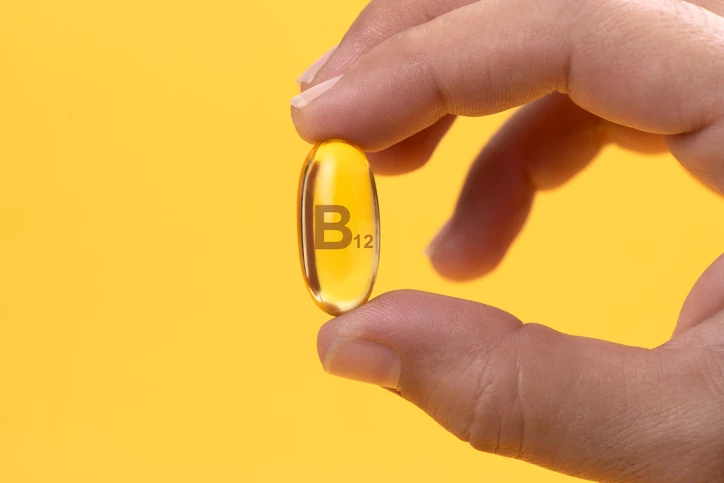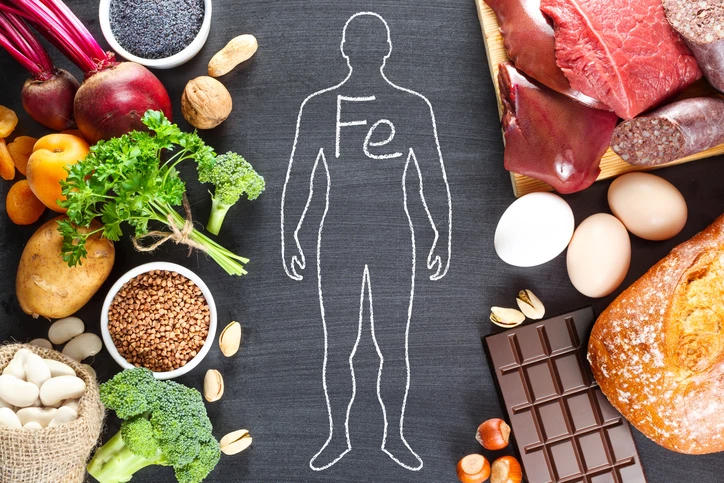Protein sources in a vegetarian diet – what to replace meat with
Plant-based diets are gaining popularity for health and ethical reasons, and recently also for environmental reasons. Eliminating or limiting meat consumption requires finding other sources of protein, iron, zinc, and vitamin B12. Dry legume seeds (e.g. soybeans, lentils, chickpeas, peas) are a good substitute, but they are also promoted regardless of diet due to their high nutritional value (“good composition”). A novelty on the market is the so-called plant meat.

Where to get protein in a vegetarian diet? The best dietary sources are legumes, soy products and nuts.
Table of Contents
What does meat contain?
According to data from the Central Statistical Office, the average consumption of meat in 2019 per person per month in a household was 5.08 kg, including 1.53 kg of poultry products and 1.07 kg of cold cuts and other meat products. For comparison, the consumption of fish and seafood was 0.27 kg/person/month. Meat is a source of high-quality protein, iron, zinc, selenium, vitamins B12 and D. Depending on the species of animal, it may also contain a lot of saturated fat, e.g., lamb, goose, and duck contain more saturated fats than chicken or turkey. Processed meat, such as sausages, also contains a large amount of saturated fat. High consumption of saturated fats increases the risk of lipid metabolism disorders – hypercholesterolemia and the development of atherosclerosis.
| Advantages and disadvantages of eating meat | |
| ADVANTAGES | DEFECTS |
| some types of meat may contain a lot of saturated fata link between eating red and processed meat and colon cancer has been documented (IARC)Animal breeding (e.g. cattle) affects greenhouse gas emissions, water, and surface use | some types of meat may contain a lot of saturated fata link between eating red and processed meat and colon cancer has been documented (IARC)Animal breeding (e.g. cattle) affects greenhouse gas emissions, water and surface use |
As with any elimination diet, excluding a specific product from the menu should involve replacing it with another one with a similar nutritional value, i.e. in this case a similar content of protein, iron, zinc, or vitamin B12.
Vegetarian sources of protein
Traditional meat substitutes in vegetarian and vegan diets are plant sources of protein, including: dry legume seeds – especially soy and its products (e.g. tempeh, tofu).
The seeds of these plants contain a lot of protein (in the case of soybeans up to about 40%), at the same time they provide complex carbohydrates – they have a low glycemic index and fiber, iron, zinc, potassium, phosphorus, calcium, magnesium and folates. Vegetarianism usually involves elimination of animal proteins, meat products, fish and seafood. Then the sources of protein, i.e. exogenous amino acids, can be: milk and dairy products (an important source of calcium), eggs (a source of iron, magnesium, potassium, zinc and vitamins B12, A, E and K), dry legume seeds (especially soybeans, but also chickpeas , lentils, peas, beans) and preserves (e.g. hummus, tempeh, tofu), yeast flakes, cereal products (e.g. groats, whole grain pasta, seitan), and nuts (source of the so-called good fats, potassium, iron , selenium, magnesium) and seeds. Some people eliminate only red meat from their diet (semi-vegetarians), and some allow the consumption of fish and seafood (pesc-vegetarians) – according to some they are called partial vegetarians.
 A vegetarian diet must be healthy and balanced, so it is worth ensuring an adequate supply of protein and other nutrients.
A vegetarian diet must be healthy and balanced, so it is worth ensuring an adequate supply of protein and other nutrients.
| Protein content in various products of animal and plant origin | |
| Product | Amount of protein per 100 g of product |
| Selected sources of animal protein | |
| Chicken (breast without skin) | 21.5 g |
| Fresh shrimps | 20.3 g |
| Turkey (breast without skin) | 19.2 g |
| Cottage cheese (semi-skimmed) | 18.7 g |
| Fresh cod | 16.5 g |
| Fresh salmon | 12.7 g |
| Grained cottage cheese | 12.3 g |
| Chicken egg | 10.87 g |
| Natural yogurt 0% | 5.1 g |
| Milk (2% fat) | 3.5 g |
| Selected sources of plant protein | |
| Yeast flakes | Approx. 50 g (depends on the manufacturer) |
| Soy | 34.3 g |
| Seitan | Approx. 27.7 g |
| Red lentils | 25.4 g |
| Pumpkin seeds | 24.5 g |
| Pea | 23.8 g |
| Sesame seeds | 23.2 g |
| White beans | 21.4 g |
| Chickpea | 20.5 g |
| Almonds | 20 g |
| Peanuts | 18.76 g |
| Linseed | 18.3 g |
| Amaranth (grain) | 15.8 g |
| Cashew nuts | 15.3 g |
| Quinoa (quinoa, grains) | 14 g |
| cous cous | 12.8 g |
| Buckwheat groats | 12.6 g |
| Bulgur groats | 12.3 g |
| Oat flakes | 11.9 g |
| Sorghum (whole grain) | 11 g |
| Millet groats | 10.5 g |
| Soft tofu | 9.9 g |
| Brown rice | 7.1 g |
| Wholemeal rye bread | 5.9 g |
| Soy drink | 4.6 g |
Based on: Kunachowicz H., Przygoda B., Iwanow K., Nadolna I., 4th extended and updated edition, Food and Nutrition Institute, Warsaw 2017 (data available in the Dieta 6.0 program). Protein content for seitan and yeast flakes based on data from the selected manufacturer.
Sources of vitamin B12
The source of vitamin B12 can be fish, milk and dairy products, eggs (like proteins), but also fortified foods, e.g. plant drinks or breakfast cereals with added B12. For vegans, the only sources of vitamin B12 are dietary supplements and fortified foods of plant origin.
 Characteristic symptoms of vitamin B12 deficiency may include: anemia, loss of sense of taste, nausea, constipation, diarrhea, mood disorders, visual disturbances, and heart palpitations.
Characteristic symptoms of vitamin B12 deficiency may include: anemia, loss of sense of taste, nausea, constipation, diarrhea, mood disorders, visual disturbances, and heart palpitations.
Sources of vitamin D
The elimination of animal products should not significantly affect the fulfillment of the demand for vitamin D due to the recommended preventive supplementation in the autumn and winter months and the possibility of skin synthesis while ensuring adequate exposure to the sun in the summer months.
Sources of iron
An alternative to meat products as a source of iron may be: cereal products (especially those enriched with iron), green leafy vegetables (e.g. kale), fruits (especially dried ones, e.g. apricots), dry legumes, nuts and seeds. It is worth remembering that the absorption of iron found in plants (so-called non-heme iron) is much lower than the equivalent in animal products, so it is also worth ensuring the consumption of products rich in vitamin C, e.g. oranges, grapefruits, peppers, kiwi, broccoli, green peppers. , strawberries, Brussels sprouts, tomatoes, cabbage and parsley.
 Iron deficiency can cause anemia, which manifests itself in fatigue, loss of energy and weakness of the body.
Iron deficiency can cause anemia, which manifests itself in fatigue, loss of energy and weakness of the body.
Sources of selenium and zinc
Brazil nuts are a particularly rich source of selenium. Other sources are fish (e.g. tuna, halibut, sardines), seafood, dairy products and whole grain cereals. Sources of zinc are whole grain cereal products, dry legumes, nuts and seeds, if they are not eliminated, also: milk and dairy products dairy products, eggs, fish and seafood, which are also rich in protein.
Plant-based meat
Currently, there is increasing interest in reducing meat consumption. Solutions that aim to reduce the market share of traditional animal breeding include plant-based meat and meat produced using cell-based meat. from a test tube, produced in a laboratory). These innovative products are an alternative to traditional animal breeding and slaughter. Plant-based meat is already available on the Polish market (e.g. burgers, sausages), in the case of meat, the so-called you still need to be patient from the test tube.
Produced exclusively from plants and proteins of plant origin (e.g. soy protein, pea protein, mushrooms) and is intended to resemble traditional meat in terms of appearance, taste and nutritional value. It does not contain meat or any ingredients of animal origin. This is a solution not only for vegans and vegetarians, but also for people who simply want to reduce their meat consumption, e.g. flexitarians. Before such meat was created, vegans were already using various products to replace it, such as soy, seitan, tempeh and tofu.
The product is still more expensive than traditionally raised meat, which is mainly due to the cost of production, as plant proteins are usually cheaper than those of animal origin, but it is now widely available.
Adapted from: Gaydhane MK, Mahanta U, Sharma CS, Khandelwal M, Ramakrishna S (2018) Cultured meat: state of the art and future. Biomanufacturing Rev 3:1–10.
Does plant-based meat provide similar nutrients to traditional meat?
Various proteins are often combined in a plant-based diet to make the final product a source of complete protein – i.e. meat. An example would be combining legumes (poor in sulfur amino acids and rich in lysine) and cereals (containing a sufficient amount of lysine and low in sulfur amino acids), which complement each other.
The advantages of plant meat compared to traditional meat are the presence of fiber and a lower content of saturated fats – they may contain them if palm or coconut fat is added, but their amount may still be lower compared to the animal equivalent.
There are ongoing discussions whether the so-called such a product should be called meat, which could indicate similarity, e.g. in the context of nutritional value. Currently, there are no regulations that would require that plant meat provide a similar amount of protein, iron, zinc or vitamin B12.
In an analysis of plant-based burgers, sausages and mince available in the Sydney market, compared to traditional meat, they contained less energy (kilocalories) in the case of mince and sausages, as well as total fat and saturated fat in the case of burgers and sausages. Plant-based meats were richer in carbohydrates, fast sugars and dietary fiber. Plant-based sausages contained less sodium than meat sausages, but plant-based minced meat contained up to 6 times more sodium than its traditional counterpart. There were no differences in the iron content in plant sausages and minced meat compared to their animal counterparts. Among the analyzed plant products, less than a quarter were enriched with vitamin B12, one fifth with iron, and 18 percent. in zinc. The composition of products available on the market varies, so it is worth reading the labels.
Plant-based meats may be perceived as processed food, which may discourage this group of consumers who prefer fresh and minimally processed food. But nothing is lost – you can still prepare your own plant burgers at home, e.g. from beetroot, sweet potatoes, legumes – then you can season your dishes according to your preferences and add the ingredients you want, and most importantly, we know what we are consuming.
| Consumer opinion Product acceptance varies. There was a high acceptance rate among consumers from China (95.6%), India (94.5%), and slightly lower among residents of the USA (74.7%). The main barriers to introducing this type of meat to the “family table” were: poor familiarity with this group of products and low sensory attractiveness. The product’s taste, current eating habits, convenience and price were also important. |
Cell cultured meat
In vitro meat, unlike traditional animal breeding, is produced using cell culture. It uses stem cell and tissue engineering technologies. The problem of meat obtained in tissue culture is still the price, mainly due to the cost of production – but producers are trying to lower it so that it can be widely available food. Information regarding the nutritional value of this meat is not yet known.
Cell cultured meat is developed mainly for people who are currently meat lovers – to reduce the consumption of traditional meat and farmed animals, but may also find interest among people who already follow plant-based diets. The main barriers to the consumption of this type of meat are: unnaturalness, safety, healthiness, taste, consistency and price.
Adapted from: Gaydhane MK, Mahanta U, Sharma CS, Khandelwal M, Ramakrishna S (2018) Cultured meat: state of the art and future. Biomanufacturing Rev 3:1–10. www.cfs.gov.hk (accessed: March 9, 2021). Rubio NR, Xiang N, Kaplan DL. Plant-based and cell-based approaches to meat production. Nat Commun. 2020 Dec 8;11(1):6276. doi: 10.1038/s41467-020-20061-y.
Why is it worth eating less meat?
Limiting meat consumption for the sake of the environment and health.
We face the excessive consumption of meat and animal products in developed countries. According to the EAT-Lancet Commission report, a diet based mainly on plant-based products and limiting meat and other animal products is associated with benefits for both health and the environment. Meat and derived products, especially red meat (e.g. beef, pork), have a relatively high carbon footprint per serving compared to other food groups – which translates into high greenhouse gas emissions, land use and reduced biodiversity. Reducing the consumption of meat, especially red meat, and increasing the proportion of plant products in your diet are the main assumptions of the planetary diet.
Learn more about the planetary diet.
Limiting meat consumption for the sake of health
Red and processed meats have a documented association with the risk of colon cancer (they have been recognized as carcinogens by the International Group for Research on Cancer [IARC]). Vegetarian diets may also be important in the prevention of obesity, type 2 diabetes, cardiovascular diseases or supporting the treatment of certain diseases, e.g. circulatory system or gout. Red meat includes beef, veal, pork, lamb, horse and goat meat, and sheep meat. . Processed meat is e.g. hot dogs, sausages, ham, dried beef (i.e. meat that has been subjected to salting, fermentation, smoking or any other process that enhances flavor or preserves it). Recommendation to limit the consumption of red meat and meat products and replace it with poultry, fish, eggs, legumes and nuts also appear in the current healthy eating recommendations (from 2020). The authors propose to implement this recommendation in 3 steps:
- introduce one day a week without meat,
- after some time, try to limit the consumption of red meat and meat products (i.e. cold meats) to max. 500 g per week and replace them with other sources of protein (e.g. dry legumes, fish, eggs),
- for health and the environment, replace meat with sources of protein of plant origin (i.e. dry legumes, nuts), but also with fish and eggs.
Reference:
- Agnoli C, Baroni L, Bertini I, Ciappellano S, Fabbri A, Papa M, Pellegrini N, Sbarbati R, Scarino ML, Siani V, Sieri S. Position paper on vegetarian diets from the working group of the Italian Society of Human Nutrition. Nutr Metab Cardiovasc Dis. 2017 Dec;27(12):1037-1052.
- Gaydhane MK, Mahanta U, Sharma CS, Khandelwal M, Ramakrishna S (2018) Cultured meat: state of the art and future. Biomanufacturing Rev 3:1–10.
- www.cfs.gov.hk (accessed: March 9, 2021).
- Rubio NR, Xiang N, Kaplan DL. Plant-based and cell-based approaches to meat production. Nat Commun. 2020 Dec 8;11(1):6276. doi: 10.1038/s41467-020-20061-y.
- Curtain F, Grafenauer S. Plant-Based Meat Substitutes in the Flexitarian Age: An Audit of Products on Supermarket Shelves. Nutrients. 2019 Oct 30;11(11):2603. doi: 10.3390/nu11112603.
- EAT-Lancet Commission brief for Healthcare Professionals.
- EAT-Lancet Commission. Summary Report of the EAT-Lancet Commission. Healthy Diets From Sustainable Food Systems. Food Planet Health. 2019.
- International Agency for Research on Cancer (IARC). Monographs evaluate consumption of red meat and processed meat, 26 October 2015, www.iarc.who.int .
- Prepared on the basis of: National Center for Nutrition Education – National Institute of Hygiene (2020). Principles of healthy eating. In 3 steps to health – what’s new!
- Kuang H, Yang F, Zhang Y, Wang T, Chen G. The Impact of Egg Nutrient Composition and Its Consumption on Cholesterol Homeostasis. Cholesterol. 2018;2018:6303810. Published 2018 Aug 23. doi:10.1155/2018/6303810
- ncez.pl/życzenie-w-placowkach-edukacyjne/zasady-zdroowego-żywienia/mieso–ryby–nasiona-roslin-straczkowe-i-jaja-w-zywieniu-dzieci-i-mlodziezy–praktyczne-wskazowki- ( access: March 10, 2021).
- stat.gov.pl/aktualnosci/korekta-dani-o-spozyciu-miesa-w-publikacji-rolnictwo-w-2019-r-,309,1.html (accessed: March 10, 2020).
- Central Statistical Office (GUS). Household budgets in 2019, stat.gov.pl/obszary-tematyczne/warunki-zycia/dochody-wydatki-i-warunki-zycia-ludnosci/budzety- Gospodarstw-domowych-w-2019-roku,9,14. html (accessed: March 10, 2021).
- National Institute of Health. Selenium. Fact Sheet for Health Professionals, ods.od.nih.gov . (accessed: March 10, 2021).
- USDA Nutrient Database, fdc.nal.usda.gov (accessed March 10, 2021).
- National Institute of Health. Vitamin C. Fact Sheet for Health Professionals, ods.od.nih.gov/factsheets/VitaminC-HealthProfessional/ (accessed: March 10, 2021).
| The presented medical information should not be treated as guidelines for medical treatment for each patient. The medical procedure, including the scope and frequency of diagnostic tests and/or therapeutic procedures, is decided individually by the doctor, in accordance with medical indications, which he determines after reviewing the patient’s condition. The doctor makes the decision in consultation with the patient. If the patient wants to perform tests that are not covered by medical indications, the patient has the option of having them performed for a fee. |
